Java is one of the best languages one can learn when stepping into the world of programming. The main reason is that Java is an OOP (Object Oriented Programming) language, making it closer to the real world.
Despite being started in 1992, Java is still being actively used for the development of software across the globe. According to Glassdoor, the national average salary for a Java Developer is around $87,000 in the United States.
Looking at the above statistics you must have understood that becoming a Java developer is not all you have on your plate, applying it to develop and deploy some simple and fun projects is more important to give your resume a push in the software industry.
Before jumping into to practice some amazing Java Projects for Beginners in 2024, let’s understand briefly why Java is so popular.
Why do Companies prefer Java for building Software?
About 30.55% of professional developers around the world make use of Java programming as their core technology. It is in much demand in real-world applications because of the following reasons:
- Unlike other programming languages, Java uses both a compiler and an interpreter for the conversion of a high-level language into machine code.
- Being an object-oriented programming language, Java is much closer to the real world than most other languages, with concepts like Abstraction, encapsulation, inheritance, and polymorphism.
- Java quickly became a favorite of the software industry because it made the development process more efficient and solved the problem of software distribution across platforms.
- Java’s memory management is quite robust by nature. Java handles garbage collection automatically without the user needing to worry about it.
- Java's usefulness has grown over the years as programmers develop new ways to use it on servers, bringing performance and scalability to a whole new level.
It is often a programmer’s dilemma as to what they can build with the concepts they have learned via some tutorial on the Internet. Good project ideas, especially ones that help boost your portfolio and improve your understanding of the underlying concepts are hard to come by.
Our list suggests some fun Java project ideas for beginners with fresh topics programmers that should get you started.
Why Java Practice Projects are Important?
Java continues to be a programming language that is in much demand. But sadly, just mentioning “I know Java” on your resume isn’t going to be enough, is it? Showing recruiters that you can work your way through Java with some real-world projects is going to look better.
Projects are a way to show that one understands the underlying concepts of the programming language and is ready to apply them to solve real-world problems. Project-based learning helps teach many concepts that the main theory can never teach.
Implementing a few Java practice projects not only demonstrates how Java works behind the scenes but also helps boost the portfolio. These projects don’t have to be very complex; they should be something basic, which puts some of Java’s many features into play.
Best 25 Java Projects for Beginners in 2024
Let's first look at all Java Project Ideas in the list below:
-
Bank Management Software
-
Temperature Converter
-
Electricity Billing System
-
Supermarket Billing Software
-
Memory Game
-
Link Shortener
-
Chatting Application
-
Digital Clock
-
Quizzing app
-
Email-Client Software
-
Student Management System
-
Airline Reservation System
-
Food Ordering System
-
Text-based RPG (role-playing game)
-
Media Player Application
-
Currency Converter
-
Brick Breaker Game
-
Number Guessing Game
-
Tic-Tac-Toe Game
-
Word Counter
- Online Quiz Platform
- Health and Fitness Tracker
- Appointment Scheduler
- Online Auction System
- Language Learning App
As a beginner, it might be difficult to come up with ideas for projects, that's why we have decided to curate a list of amazing Java projects for beginners.
1) Bank Management Software

Perhaps the simplest software that you can work with is the one that allows you to deal with bank accounts and transactions regarding it. Designing a robust system that allows you to engage in transactions is something that every beginner should get started with.
The proposed system is a web-based project that allows you to do everything a bank would allow you to do naturally. One should be able to deposit money and withdraw money from a particular account as the user desires.
There should be a validation to allow only a particular amount of cash inflows at any time, as well as to allow withdrawals if the balance is sufficient. There should also be the calculation of interest and its addition to the balance every month.
There can be multiple improvements for this project, including adding support for multiple types of accounts. We started with this because it is still one of the most popular Java projects for beginners.
Source code:
import java.util.Scanner; public class BankApplication { public static void main(String[] args) { Scanner sc=new Scanner(System.in); System.out.println("Enter your 'Name' and 'CustomerId' to access your Bank account:"); String name=sc.nextLine(); String customerId=sc.nextLine(); BankAccount obj1=new BankAccount(name,customerId); obj1.menu(); } } class BankAccount{ double bal; double prevTrans; String customerName; String customerId; BankAccount(String customerName,String customerId){ this.customerName=customerName; this.customerId=customerId; } void deposit(double amount){ if(amount!=0){ bal+=amount; prevTrans=amount; } } void withdraw(double amt){ if(amt!=0 && bal>=amt){ bal-=amt; prevTrans=-amt; } else if(bal<amt){ System.out.println("Bank balance insufficient"); } } void getPreviousTrans(){ if(prevTrans>0){ System.out.println("Deposited: "+prevTrans); } else if(prevTrans<0){ System.out.println("Withdrawn: "+Math.abs(prevTrans)); } else{ System.out.println("No transaction occured"); } } void menu(){ char option; Scanner sc=new Scanner(System.in); System.out.println("Welcome "+customerName); System.out.println("Your ID:"+customerId); System.out.println("\n"); System.out.println("a) Check Balance"); System.out.println("b) Deposit Amount"); System.out.println("c) Withdraw Amount"); System.out.println("d) Previous Transaction"); System.out.println("e) Exit"); do{ System.out.println("********************************************"); System.out.println("Choose an option"); option=sc.next().charAt(0); System.out.println("\n"); switch (option){ case 'a': System.out.println("......................"); System.out.println("Balance ="+bal); System.out.println("......................"); System.out.println("\n"); break; case 'b': System.out.println("......................"); System.out.println("Enter a amount to deposit :"); System.out.println("......................"); double amt=sc.nextDouble(); deposit(amt); System.out.println("\n"); break; case 'c': System.out.println("......................"); System.out.println("Enter a amount to Withdraw :"); System.out.println("......................"); double amtW=sc.nextDouble(); withdraw(amtW); System.out.println("\n"); break; case 'd': System.out.println("......................"); System.out.println("Previous Transaction:"); getPreviousTrans(); System.out.println("......................"); System.out.println("\n"); break; case 'e': System.out.println("......................"); break; default: System.out.println("Choose a correct option to proceed"); break; } }while(option!='e'); System.out.println("Thank you for using our banking services"); } }
2) Temperature Converter
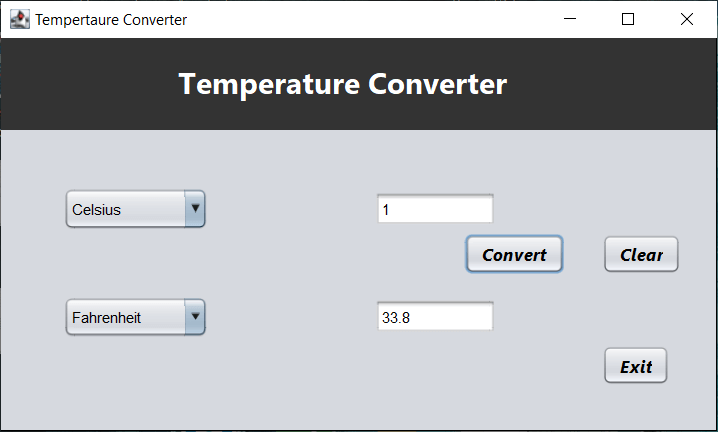
One of the best ways to get started with Java practice projects is by building conversion tools, and what could be simpler than a temperature conversion tool? One already knows the mathematical formula needed for conversion from Fahrenheit to Celsius and from Celsius to Fahrenheit.
In this tool, we have to take input for the value to be converted, do the desired conversion, and then output the converted value. There is also the concept of sanitizing the text being input and displaying an error for incorrect values. There should be a proper error if a non-numerical value is inserted as input.
Source Code:
public class Temperature_converter extends javax.swing.JFrame { //Variable Declaration private javax.swing.JButton jButton1; private javax.swing.JButton jButton2; private javax.swing.JButton jButton3; private javax.swing.JCheckBox jCheckBox2; private javax.swing.JComboBox<String> jComboBox1; private javax.swing.JComboBox<String> jComboBox2; private javax.swing.JLabel jLabel1; private javax.swing.JPanel jPanel2; private javax.swing.JSpinner jSpinner1; private javax.swing.JTextField jTextField1; private javax.swing.JTextField jTextField2; public Temperature_converter() { initComponents(); } private void initComponents() { jCheckBox2 = new javax.swing.JCheckBox(); jSpinner1 = new javax.swing.JSpinner(); jPanel2 = new javax.swing.JPanel(); jLabel1 = new javax.swing.JLabel(); jComboBox1 = new javax.swing.JComboBox<>(); jComboBox2 = new javax.swing.JComboBox<>(); jTextField1 = new javax.swing.JTextField(); jTextField2 = new javax.swing.JTextField(); jButton1 = new javax.swing.JButton(); jButton2 = new javax.swing.JButton(); jButton3 = new javax.swing.JButton(); jCheckBox2.setText("jCheckBox2"); setDefaultCloseOperation(javax.swing.WindowConstants.EXIT_ON_CLOSE); setTitle("Tempertaure Converter"); jPanel2.setBackground(new java.awt.Color(51, 51, 51)); jLabel1.setBackground(new java.awt.Color(255, 255, 255)); jLabel1.setFont(new java.awt.Font("Segoe UI", 1, 24)); // NOI18N jLabel1.setForeground(new java.awt.Color(255, 255, 255)); jLabel1.setText("Temperature Converter "); javax.swing.GroupLayout jPanel2Layout = new javax.swing.GroupLayout(jPanel2); jPanel2.setLayout(jPanel2Layout); jPanel2Layout.setHorizontalGroup( jPanel2Layout.createParallelGroup(javax.swing.GroupLayout.Alignment.LEADING) .addGroup(jPanel2Layout.createSequentialGroup() .addGap(142, 142, 142) .addComponent(jLabel1) .addContainerGap(161, Short.MAX_VALUE)) ); jPanel2Layout.setVerticalGroup( jPanel2Layout.createParallelGroup(javax.swing.GroupLayout.Alignment.LEADING) .addGroup(jPanel2Layout.createSequentialGroup() .addGap(19, 19, 19) .addComponent(jLabel1) .addContainerGap(23, Short.MAX_VALUE)) ); jComboBox1.setModel(new javax.swing.DefaultComboBoxModel<>(new String[] { "Celsius", "Fahrenheit" })); jComboBox2.setModel(new javax.swing.DefaultComboBoxModel<>(new String[] { "Celsius", "Fahrenheit" })); jTextField2.setEditable(false); jButton1.setFont(new java.awt.Font("Segoe UI", 3, 14)); // NOI18N jButton1.setText("Convert"); jButton1.addActionListener(new java.awt.event.ActionListener() { public void actionPerformed(java.awt.event.ActionEvent evt) { jButton1ActionPerformed(evt); } }); jButton2.setFont(new java.awt.Font("Segoe UI", 3, 14)); // NOI18N jButton2.setText("Clear"); jButton2.addActionListener(new java.awt.event.ActionListener() { public void actionPerformed(java.awt.event.ActionEvent evt) { jButton2ActionPerformed(evt); } }); jButton3.setFont(new java.awt.Font("Segoe UI", 3, 14)); // NOI18N jButton3.setText("Exit"); jButton3.addActionListener(new java.awt.event.ActionListener() { public void actionPerformed(java.awt.event.ActionEvent evt) { jButton3ActionPerformed(evt); } }); javax.swing.GroupLayout layout = new javax.swing.GroupLayout(getContentPane()); getContentPane().setLayout(layout); layout.setHorizontalGroup( layout.createParallelGroup(javax.swing.GroupLayout.Alignment.LEADING) .addGroup(layout.createSequentialGroup() .addGap(50, 50, 50) .addGroup(layout.createParallelGroup(javax.swing.GroupLayout.Alignment.LEADING, false) .addComponent(jComboBox2, 0, javax.swing.GroupLayout.DEFAULT_SIZE, Short.MAX_VALUE) .addComponent(jComboBox1, 0, 116, Short.MAX_VALUE)) .addGap(133, 133, 133) .addGroup(layout.createParallelGroup(javax.swing.GroupLayout.Alignment.LEADING) .addComponent(jTextField1, javax.swing.GroupLayout.PREFERRED_SIZE, 97, javax.swing.GroupLayout.PREFERRED_SIZE) .addComponent(jTextField2, javax.swing.GroupLayout.PREFERRED_SIZE, 97, javax.swing.GroupLayout.PREFERRED_SIZE)) .addContainerGap(javax.swing.GroupLayout.DEFAULT_SIZE, Short.MAX_VALUE)) .addGroup(javax.swing.GroupLayout.Alignment.TRAILING, layout.createSequentialGroup() .addContainerGap(javax.swing.GroupLayout.DEFAULT_SIZE, Short.MAX_VALUE) .addComponent(jButton1) .addGap(30, 30, 30) .addGroup(layout.createParallelGroup(javax.swing.GroupLayout.Alignment.LEADING) .addComponent(jButton3) .addComponent(jButton2)) .addGap(29, 29, 29)) .addComponent(jPanel2, javax.swing.GroupLayout.DEFAULT_SIZE, javax.swing.GroupLayout.DEFAULT_SIZE, Short.MAX_VALUE) ); layout.setVerticalGroup( layout.createParallelGroup(javax.swing.GroupLayout.Alignment.LEADING) .addGroup(layout.createSequentialGroup() .addComponent(jPanel2, javax.swing.GroupLayout.PREFERRED_SIZE, javax.swing.GroupLayout.DEFAULT_SIZE, javax.swing.GroupLayout.PREFERRED_SIZE) .addGap(46, 46, 46) .addGroup(layout.createParallelGroup(javax.swing.GroupLayout.Alignment.BASELINE) .addComponent(jComboBox1, javax.swing.GroupLayout.PREFERRED_SIZE, 34, javax.swing.GroupLayout.PREFERRED_SIZE) .addComponent(jTextField1, javax.swing.GroupLayout.PREFERRED_SIZE, javax.swing.GroupLayout.DEFAULT_SIZE, javax.swing.GroupLayout.PREFERRED_SIZE)) .addGap(3, 3, 3) .addGroup(layout.createParallelGroup(javax.swing.GroupLayout.Alignment.BASELINE) .addComponent(jButton1) .addComponent(jButton2)) .addGap(18, 18, 18) .addGroup(layout.createParallelGroup(javax.swing.GroupLayout.Alignment.BASELINE) .addComponent(jComboBox2, javax.swing.GroupLayout.PREFERRED_SIZE, 33, javax.swing.GroupLayout.PREFERRED_SIZE) .addComponent(jTextField2, javax.swing.GroupLayout.PREFERRED_SIZE, javax.swing.GroupLayout.DEFAULT_SIZE, javax.swing.GroupLayout.PREFERRED_SIZE)) .addPreferredGap(javax.swing.LayoutStyle.ComponentPlacement.RELATED, javax.swing.GroupLayout.DEFAULT_SIZE, Short.MAX_VALUE) .addComponent(jButton3) .addGap(37, 37, 37)) ); pack(); }// private void jButton3ActionPerformed(java.awt.event.ActionEvent evt) { System.exit(0); } private void jButton2ActionPerformed(java.awt.event.ActionEvent evt) { jTextField1.setText(""); jTextField2.setText(""); } private void jButton1ActionPerformed(java.awt.event.ActionEvent evt) { String val1=(String)jComboBox1.getSelectedItem(); String val2=(String)jComboBox2.getSelectedItem(); if(val1.equals("Celsius") && val2.equals("Fahrenheit")){ double cel = Double.parseDouble(jTextField1.getText()); double fah = (double)((9.0/5.0)*cel + 32); jTextField2.setText(String.valueOf(fah)); } else if(val1.equals("Celsius") && val2.equals("Celsius")) { double c = Double.parseDouble(jTextField1.getText()); jTextField2.setText(String.valueOf(c)); } if(val1.equals("Fahrenheit") && val2.equals("Celsius")) { double f = Double.parseDouble(jTextField1.getText()); double c = (double)((f - 32)*(5.0/9.0)); jTextField2.setText(String.valueOf(Math.round(c))); } else if(val1.equals("Fahrenheit") && val2.equals("Fahrenheit")) { double f = Double.parseDouble(jTextField1.getText()); jTextField2.setText(String.valueOf(Math.round(f))); } } /** * @param args the command line arguments */ public static void main(String args[]) { try { for (javax.swing.UIManager.LookAndFeelInfo info : javax.swing.UIManager.getInstalledLookAndFeels()) { if ("Nimbus".equals(info.getName())) { javax.swing.UIManager.setLookAndFeel(info.getClassName()); break; } } } catch (ClassNotFoundException ex) { java.util.logging.Logger.getLogger(Temperature_converter.class.getName()).log(java.util.logging.Level.SEVERE, null, ex); } catch (InstantiationException ex) { java.util.logging.Logger.getLogger(Temperature_converter.class.getName()).log(java.util.logging.Level.SEVERE, null, ex); } catch (IllegalAccessException ex) { java.util.logging.Logger.getLogger(Temperature_converter.class.getName()).log(java.util.logging.Level.SEVERE, null, ex); } catch (javax.swing.UnsupportedLookAndFeelException ex) { java.util.logging.Logger.getLogger(Temperature_converter.class.getName()).log(java.util.logging.Level.SEVERE, null, ex); } java.awt.EventQueue.invokeLater(new Runnable() { public void run() { new Temperature_converter().setVisible(true); } }); } }
3) Electricity Billing System

The main task of designing software is to automate something with greater efficiency. In our day-to-day lives, one of the biggest systems that are in dire need of automation is the billing system for electricity.
Till today, bills are generated manually after readings are taken. Work done to automate reading meters and generating bills will go a long way in ensuring work is done in the most efficient way possible while ensuring accuracy in the numbers quoted on the bills.
There are lots of additions that can be done to ensure this remains on top. There aren’t any hard and fast requirements for a flexible mini-project like this one.
4) Supermarket Billing Software

Most supermarkets use software for preparing the final bill before the goods are packed. This software itself can very easily be designed by someone starting in Java. (Note that most of the actual software used for billing in supermarkets uses Java itself).
This billing software sums the amount for individual items and then adds them up to get the final sum that the customer has to pay. The number of individual items and the price of each item should be editable for the user. Also, there should be an option to remove the item from the list altogether.
If one wants to extend their project, one can consider adding an option to export existing bills or implement a way to save previous bills in memory.
5) Memory Game
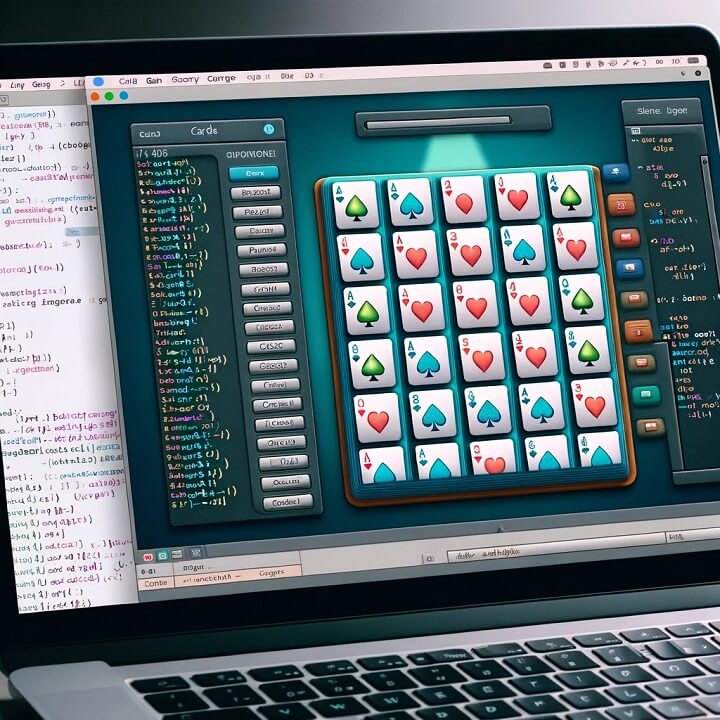
This might be one of the most unique projects that one can come up with while learning the game. Java’s graphics library allows the design of a wide range of small video games that can easily go up on your resume.
In a memory game, a matrix consisting of a large number of smaller boxes will be available, and the user’s task will be to win the game by matching patterns on particular boxes.
When the user clicks one box, it should show its pattern – if the next box clicked on has a similar pattern, both boxes should remain flipped and the score should be added. If the second box flipped does not have a similar pattern, both boxes should stop showing their pattern.
There is a lot of scope in doing this, and a lot of possible improvements. For instance, there can be a way of storing the number of moves required as well as a leaderboard system for hosting folks that have the best memory possible.
6) Link Shortener

This might seem like something too basic, but it’s something that should exist on your portfolio (if you want to be a good programmer, that is). A good link shortener does wonders in proving not your skills in Java, but your skills in understanding data structures and algorithms.
Hashing is the main concept required for building something, but the challenge is getting it to run on all browsers and point to the actual page instead of showing an error. There should be some validation to check if the link inserted is a proper link or not, and then the appropriate logic should be applied to “shorten” it.
Oh yes, there should be a proper error telling the user that the link entered isn’t a proper link. One improvement that can be done here is adding some sort of history for the application for storing previously shortened links, and for adding an option to add the shortened link to the clipboard directly.
7) Chatting Application
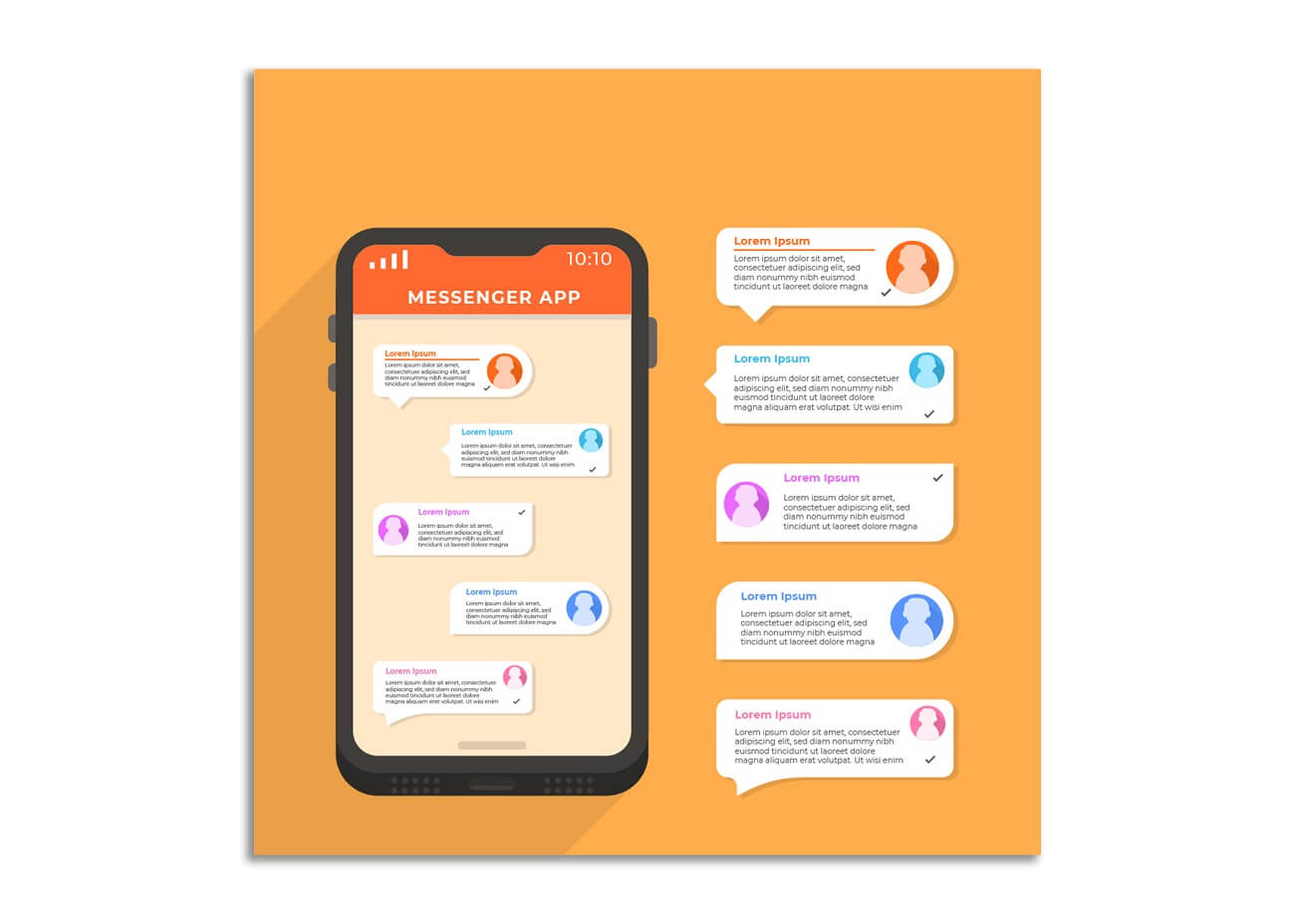
Wondering what a “chatting” application is doing on a list of beginners' projects about Java? Turns out that Java has quite some intense support for network-based libraries too. However, instead of basic request-based communication, this application will need to communicate through sockets.
There are multiple ways to implement this and is probably one of the best ways for people to learn the networking functionality available with Java. A good GUI works wonders in improving the project and improving its appeal to the users.
However, it would be cool if support could be added for file transfer besides normal chat messages. After all, messaging applications would not have come so far if it wasn’t possible to send songs and funny clips to your friends and family, would it?
8) Digital Clock

Another simple and easy-to-implement project that you can show off is a digital clock. Some knowledge of UI design is needed here if a visually pleasing design is wanted (which does help a lot!). This requires some event handling as well as periodic execution functions to achieve the desired effect.
Extra features such as other modes, including that of a stopwatch and a counter can be made to improve the project’s output. If that itself isn’t challenging enough, adding the option to move between time zones and show the time according to the time zone selected is certainly going to be a challenge.
Source Code:
import javax.swing.*; import java.awt.*; import java.text.SimpleDateFormat; import java.util.Calendar; public class Clock extends JFrame { Calendar calendar; SimpleDateFormat timeFormat; SimpleDateFormat dayFormat; SimpleDateFormat dateFormat; JLabel timeLabel; JLabel dayLabel; JLabel dateLabel; String time; String day; String date; Clock() { this.setDefaultCloseOperation(JFrame.EXIT_ON_CLOSE); this.setTitle("Digital Clock"); this.setLayout(new FlowLayout()); this.setSize(350, 220); this.setResizable(false); timeFormat = new SimpleDateFormat("hh:mm:ss a"); dayFormat=new SimpleDateFormat("EEEE"); dateFormat=new SimpleDateFormat("dd MMMMM, yyyy"); timeLabel = new JLabel(); timeLabel.setFont(new Font("SANS_SERIF", Font.PLAIN, 59)); timeLabel.setBackground(Color.BLACK); timeLabel.setForeground(Color.WHITE); timeLabel.setOpaque(true); dayLabel=new JLabel(); dayLabel.setFont(new Font("Ink Free",Font.BOLD,34)); dateLabel=new JLabel(); dateLabel.setFont(new Font("Ink Free",Font.BOLD,30)); this.add(timeLabel); this.add(dayLabel); this.add(dateLabel); this.setVisible(true); setTimer(); } public void setTimer() { while (true) { time = timeFormat.format(Calendar.getInstance().getTime()); timeLabel.setText(time); day = dayFormat.format(Calendar.getInstance().getTime()); dayLabel.setText(day); date = dateFormat.format(Calendar.getInstance().getTime()); dateLabel.setText(date); try { Thread.sleep(1000); } catch (Exception e) { e.getStackTrace(); } } } public static void main(String[] args) { new Clock(); } }
9) Quizzing app

One of the more subtle project to practice that Java allows one to build is apps. Google built Android to be built on top of the Java ecosystem, allowing all features of the Android OS to build an app. One of the best apps to get started is probably a quiz app for distributing questions to friends!
As for extensions, one can be creative when one wants to improve this project. Authentication for users, export a set of questions from the app for use on other apps with the quiz, an online ranking system based on the number of people who have taken the quiz – the possibilities are endless.
Note that the extensions might require some expertise on the Android platform, which might not be taken upon immediately for most Java beginners. So, if you are more into app development, this is an exciting Java project idea to start with.
10) Email-Client Software

Email has been one of the most important applications of the World Wide Web since its inception. It’s extremely relevant even in today’s world, as most formal conversations take place online via email.
Designing software that allows one to deal with emails not only helps add a decent project to your resume but also allows you to explore some unexplored parts of Java. Designing a proper body with headers and then sending it via a proper channel (SMTP or POP3, depending on the media being sent) is a pretty decent task.
While the main task is to primarily send an email to a destination of the user’s choice, the project can be extended much beyond that. One can add the feature of the creation and storage of drafts for sending them later. And of course, the project becomes a bit more challenging if you need to deal with multimedia as part of the email body as well.
11) Student Management System
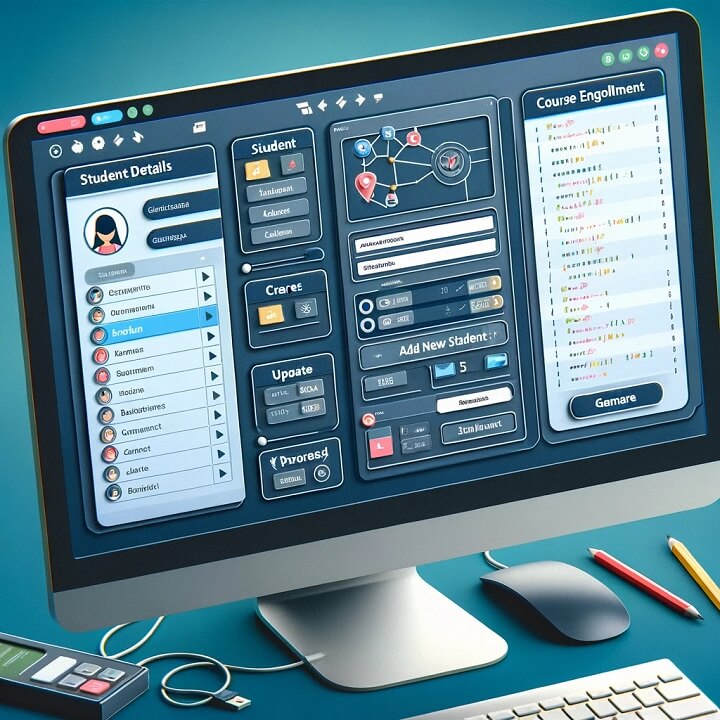
This might be something that most people already have seen in their daily lives. You see your teacher recording your attendance on a sheet, putting in feedback, uploading assignments, etc. Combine everything, and everything should be part of one sweet project to add to your portfolio!
A project as big as this should have its functionality split into three main parts depending on the type of user (which is identified at the time of authentication). These users include:
- Students: Students are designed to be consumers. They log in to access their data, download assignments, upload solutions and projects, respond to feedback provided, and so on.
- Teachers: Teachers are designed to be providers. They log in to provide details about students like feedback, update attendance, communicate with the students, upload assignments, and so on.
- Administrator: Administrators are designed to be the hierarchical elements that form the interconnecting bridge between teachers and students. They are the masters of the system; creating and editing account details, managing the mass inflow of information, checking the status of any submissions, and so on.
This project can be highly customizable and only gets more vibrant once more features are added to improve it. The more, the better.
12) Airline Reservation System
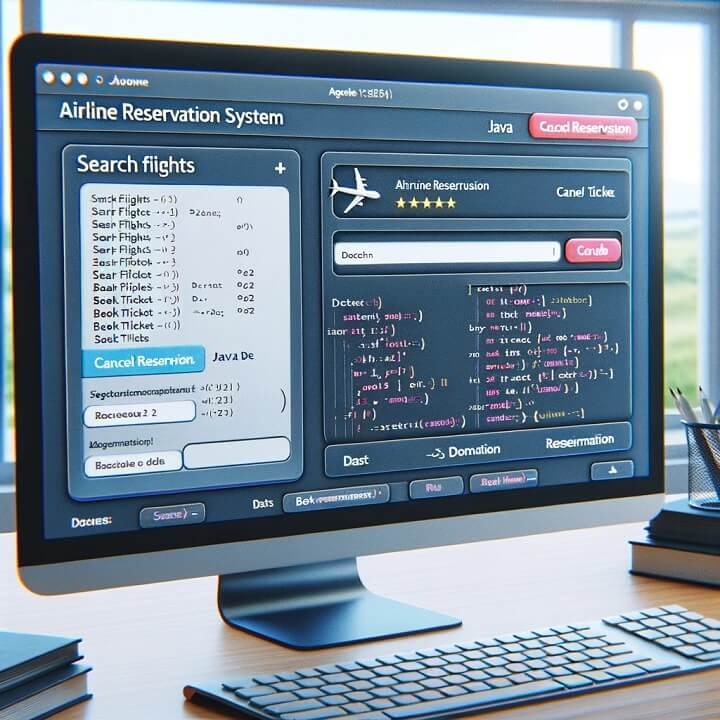
One of the best ways to try out the concepts of OOPs for yourself is with this project, probably. We have seen everyday systems where we make reservations or cancellations for flights, haven’t we?
Designing a similar system as a project can be a very good way to add to the resume! The system should be a web-based one allowing all sorts of functionality that a normal reservation system would have fulfilled.
One should be able to make reservations on certain flights after filling in the requisite data. Reservations should be saved somewhere so that they can be accessed again later for a particular user. One should also be able to cancel reservations provided the reservation to be canceled exists, else an error should be displayed.
This project is a thorough test of your database skills as well, as it requires a lot of data to be dumped and fetched at all times.
13) Food Ordering System
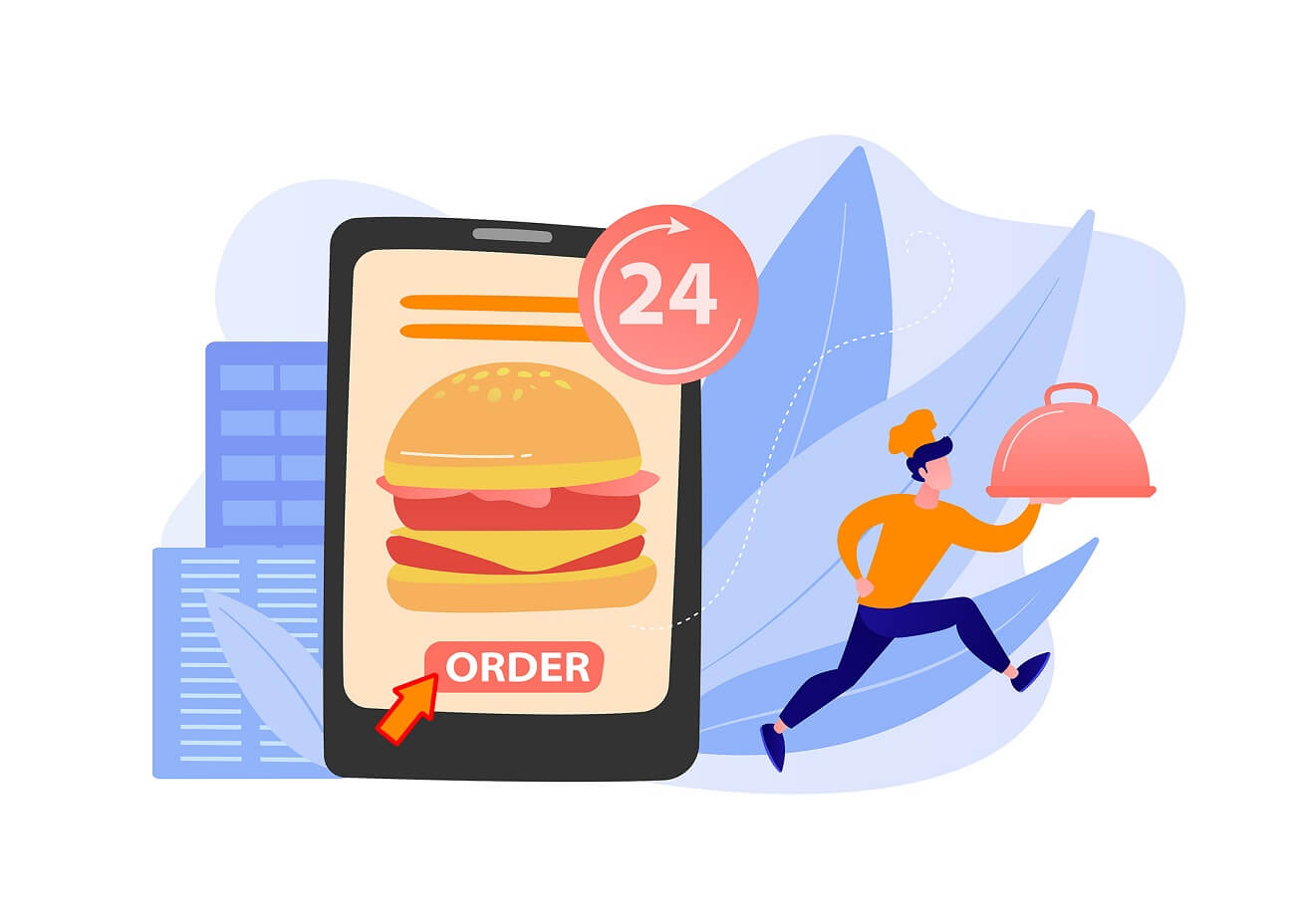
We have all eaten out at restaurants or ordered from outside. It takes a long time for the order to be taken and for our food (and later, our bill) to be delivered, right? One piece of well-designed software can help minimize queue times a lot and thus help increase the number of customers served per day.
The main functionality is to allow the user to order food and send it to the particular restaurant for which the order is being taken and show the user their bill. A sophisticated UI and other small features go a long way in improving this project.
14) Text-based RPG (role-playing game)

This might probably be one of the coolest things that one can build if they have decided to venture into Java. The idea is to allow the user to navigate their path in a video-game-based setting. The only concept is that users have to choose their next move at every point in the game.
Depending on the outcome of the move, the next choice is presented continuously till one of the conditions to end the game is triggered, which shows the score of the player and how long they survived.
This project is one of the best suggestions for people to start with, as it has less to nothing to implement, yet can be surprisingly complex to deal with. Think your basics about branching instructions and decision-making statements are good enough? This is one sure-shot way to put it to the test.
The flexibility of this project means that one can design the story of this game and its decisions and outcomes in multiple ways possible. It’s totally up to the user as to how they want to proceed with it.
15) Media Player Application

Java is a language of many merits, including the ability to deal with all types of files. We all have used some sort of media player to listen to songs or watch movies, haven’t we? Designing and creating one such media player is going to be tough, but is something that one can take up if one wants to explore more of the Java language.
A media player application may require extensive Java knowledge before it is successfully made, but it can be very rewarding to figure out how to build one. That is why it is an interesting Java project for new programmers.
This is, again, one of the projects that are extremely flexible by nature. Both an Android application and a desktop application can be designed to work as a media player. There’s also a choice to make it play only audio, or play both audio and video (in synchronization!).
Showing details of the video or audio being played as well as the ability to make playlists should also be something up the to-do list as well.
(Note that this project might take some time to implement as it involves a deep understanding of multithreading as well as file handling).
16) Currency Converter
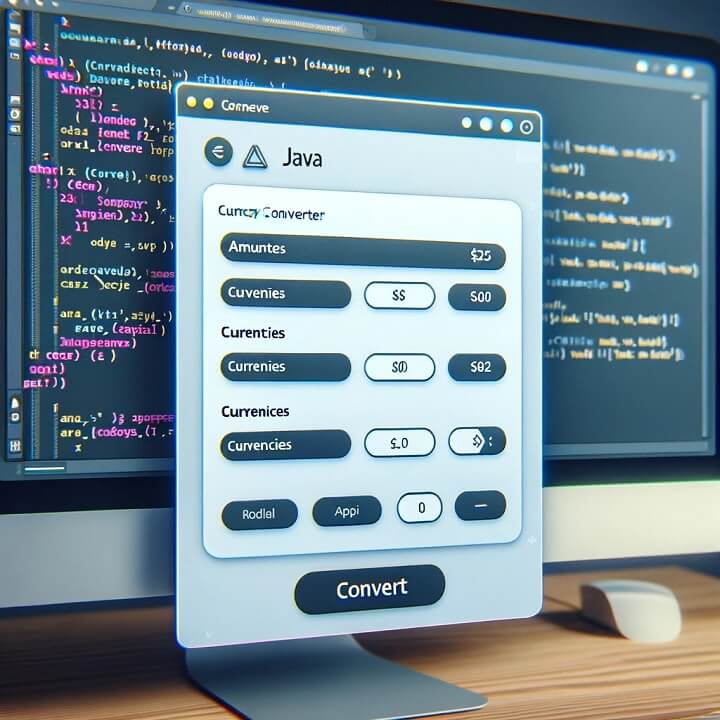
A very basic Java beginner project that is used to convert a currency from one to another. It has a web-based interface you need to just enter the amount, and the currency to which you want to transform, click enter and you get the output.
The real-life use case for this application is many people use this application basically for business, shares, and finance-related areas where the exchange of currency and money transfer happens daily. You can add multiple currencies by adding the corresponding countries with their current exchange prices in the market.
It is a calculator-type application that is developed using the Ajax, Applet, and web features of Java servlets.
17) Brick Breaker Game
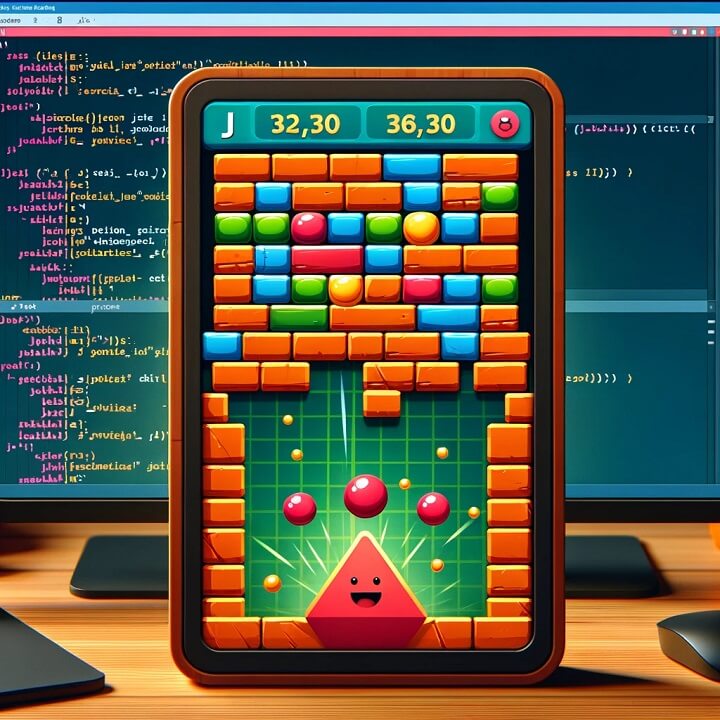
Game applications are the ones that can make your understanding of the Java project better and you would be able to see the essential animation techniques with their integration and can easily experience them. Though this Java project might not be easy for you. Let's understand what this game is about.
This game has a small ball and a small platform at the base and the small ball knocks the bricks taking the help of this small platform at the base. The control of this base is given to the player and the player tries to bounce the ball with this platform.
The number of bricks broken by the ball is the same number of points you scored. i.e., the more you destroy the bricks, the more you score.
If the ball doesn't bounce by the platform then the player will lose the game. This project is beginner-friendly, and one might use this project in their first-year projects list or can experience the implementation for fun purposes.
18) Number Guessing Game
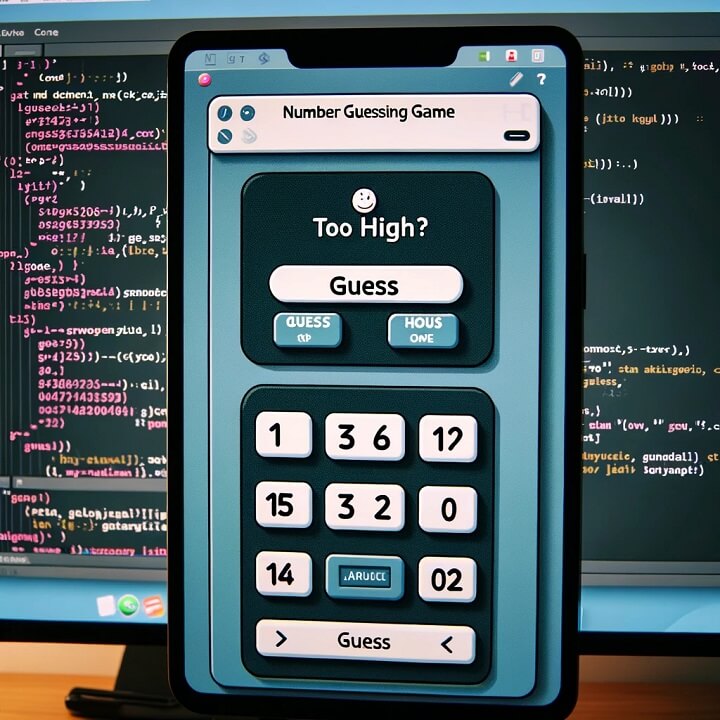
It's a very easy game to develop as a Java Developer and easy to understand as well. The only functionality provided by this application is there will be a range of numbers specified to the users, and users have to just guess the number.
If the number guessed is correct, then the player wins, else loses. You can restrict the count of guessing the numbers for the users to make this more interesting and fun.
This is a web-based application where there will be an input provided to the user and they to just guess the number in the given range and a time clock will be there. If the guessed number is correct: the player Wins ! or Loses!
If the guess value is close to the correct value, you might provide the user with a pop-up of too-close value! You need to know about Random Class in Java to make this game.
19) Tic-Tac-Toe Game
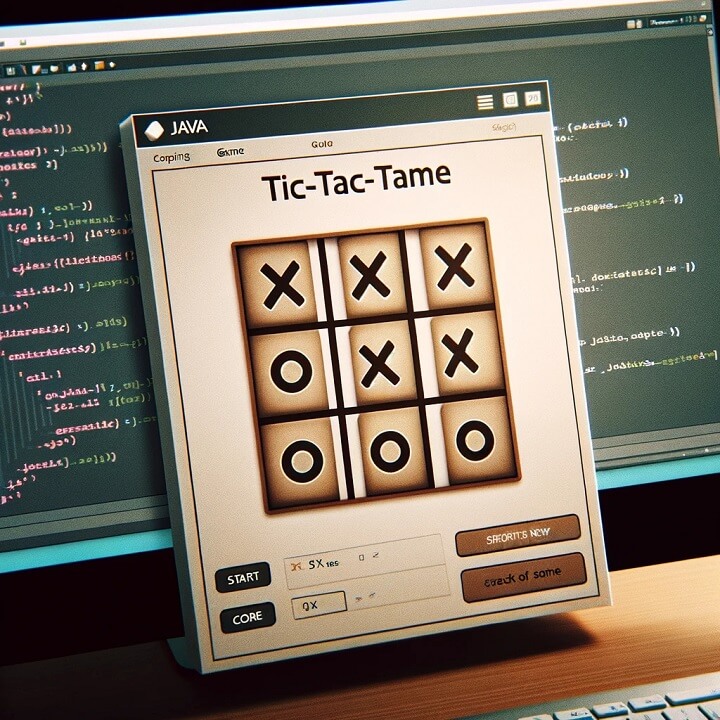
It's a very famous game that you all must be aware of. It is developed using GUI (Graphical User Interface) in Java. Players generally prefer this kind of game when they’re bored and want something to play that is quick and easy.
This game application has a 3x3 box displayed on the screen. The first person who starts the game has to enter either X or O for any one box, followed by the other player entering the other X or O. This continues unless any one of them gets a line cut either diagonally or straight. And the person who finds the line is the winner of the game.
But you first need to have an understanding of Java Swing, Java GUI (Graphical User Interface), and JFrame.
20) Word Counter

This application tells you the exact number of words used in the pasted paragraph by the user in the input. A simple project for beginners is good to start. It can be built using Swing in Java. This is a counting-word application Java-based project.
Remember, our childhood days when we were asked to write an essay on a given topic where the word length should be 500 or 1000? This application comes with a feature that could help you.
You can further add functionalities like showcasing the number of characters, words, and paragraphs it has. Also, it is completely free to use and there’s no word count limit.
21) Online Quiz Platform
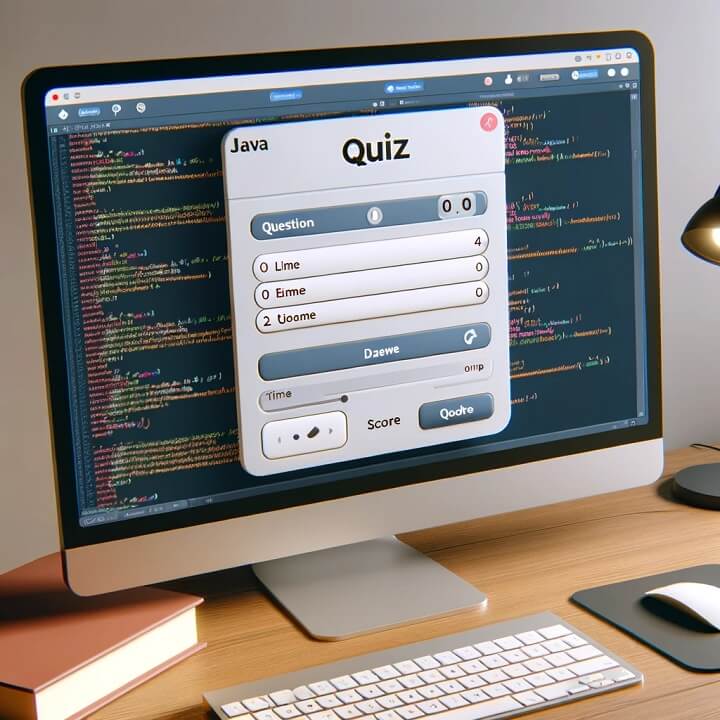
An online quiz platform can be built in Java that helps us access a diverse range of quizzes on various subjects and topics. The platform offers an interactive interface where we can select quizzes, attempt questions, receive instant feedback, and track their progress.
We can add the following features to this quiz platform:
- User Authentication: Users can create accounts, log in securely, and access quizzes based on their preferences.
- Quiz Selection: Users can choose quizzes from multiple categories such as science, mathematics, history, etc.
- Interactive Quiz Interface: Engaging user interface for displaying questions, multiple-choice answers, and providing immediate feedback.
- Scoring and Progress Tracking: Users can view their scores, track their progress, and review past quiz attempts.
- Admin Panel: Administrators can manage quizzes, add new questions, and analyze user statistics.
22) Health and Fitness Tracker
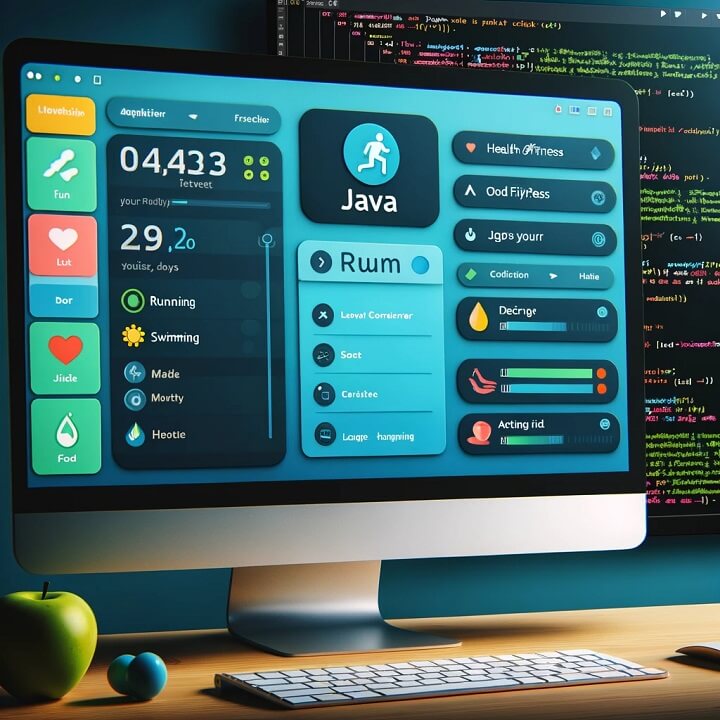
In today’s age when everyone is concerned too much about their health, a Health and Fitness Tracker can be developed in Java that serves as an invaluable tool for individuals striving for a healthier lifestyle.
The Health and Fitness Tracker is a Java-based application designed to assist users in monitoring their daily activities, nutritional intake, and overall fitness progress. It offers a comprehensive dashboard where users can input data and track their health goals.
It can help us in many ways, like:
- Personalized Health Monitoring: Users can tailor the tracker to their specific health needs and goals.
- Motivation and Accountability: The visual representation of progress serves as motivation to stay committed to a healthy lifestyle.
- Data-Driven Insights: Analyze tracked data to gain insights into habits, patterns, and areas for improvement.
23) Appointment Scheduler

Efficiently managing appointments and schedules is essential in various fields, from healthcare to business. An Appointment Scheduler developed in Java can streamline the process, ensuring organized and optimized time management.
The Appointment Scheduler application in Java provides a user-friendly platform for scheduling and managing appointments. It caters to various industries where appointment booking and management are critical.
We can implement this in simple steps:
- User Authentication and Role Management: Use frameworks like Spring Security for authentication and authorization. Implement different user roles (admin, staff, clients/customers).
- Database Setup: Use MySQL or PostgreSQL to store user details, appointment schedules, and related data.
- Calendar View and Appointment Booking:
- Utilize JavaFX for a visually appealing calendar view.
- Implement functionalities to schedule appointments and display them in the calendar.
- Search and Filter Functionality: Implement features for users to search for available slots based on date/time or service type.
24) Online Auction System

Online auctions have transformed commerce by providing a platform for buying and selling goods. Developing an Online Auction System using Java enables users to engage in exciting bidding experiences. The Online Auction System in Java offers a virtual marketplace where users can bid on items, sellers can list products, and an auctioneer manages the bidding process.
The following features can be implemented in this application:
- User Registration and Authentication: Secure login/signup for buyers, sellers, and admin roles.
- Product Listings: Sellers can add products with descriptions, images, and starting bid prices.
- Bidding Mechanism: Buyers can place bids, receive notifications on higher bids, and track auction progress.
- Auction Management: Admin panel to oversee auctions, close/open bidding, and manage listings.
- Payment Integration: Integration with payment gateways for secure transactions.
- Feedback and Rating: Users can leave feedback and rate sellers/buyers after successful transactions.
25) Language Learning App
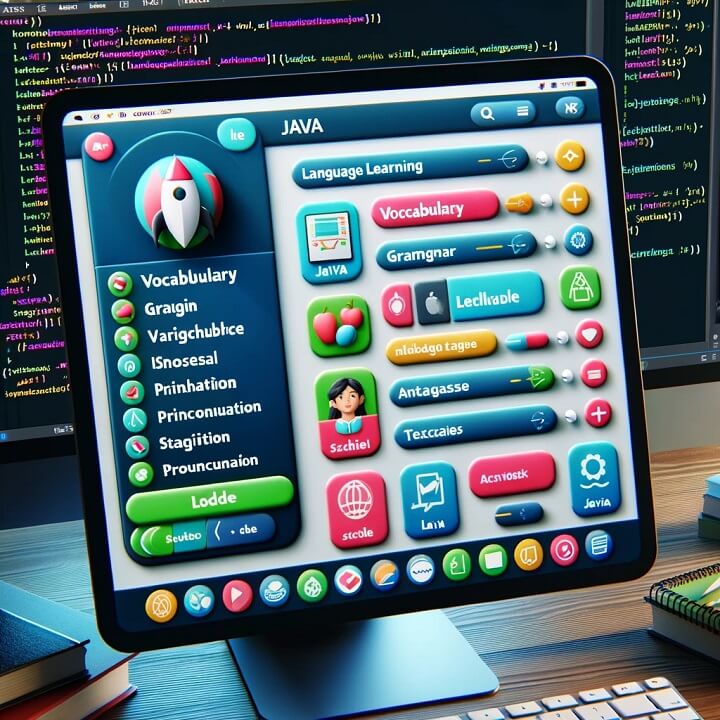
Learning a new language opens doors to new cultures and opportunities. A Language Learning App developed in Java provides an interactive platform for users to master a new language.
The Language Learning App offers a user-friendly interface with various tools and exercises to aid users in language acquisition.
We can follow the below steps to implement it:
- User Registration and Profile Creation: Allow users to register and create profiles, select their target language, and set learning goals.
- Lesson Modules and Interactive Quizzes:
- Design structured lessons covering vocabulary, grammar, listening, speaking, and writing exercises.
- Create interactive quizzes to assess language proficiency.
- Speech Recognition and Community Forums:
- Implement speech recognition features for pronunciation practice.
- Set up community forums for users to interact and practice language skills.
- Progress Tracking and Achievement System:
- Implement a system to track user progress with stats and achievements.
- Database Setup and Backend Development:
- Utilize MySQL or SQLite for database management.
- Develop backend functionalities for user data storage and retrieval.
Which Projects are Best for New Programmers?
It’s a lot of projects, isn’t it? That should be enough to get started with. Of course, even among these projects, some are easier than others. Like always, it’s wise to build stepping stones while learning any language. The mantra is to get started with the easier projects, and then move on to bigger and better ones as one’s understanding of the language improves.
The recommendation for new programmers making a project for the first time is to get started with the projects like the temperature converter, the digital clock, the link shortener, or the memory game. These are the most simple Java project ideas for beginners.
They have pretty straightforward requirements and don’t require a huge amount of time to build or code. Once the beginner projects are pretty much done and dusted, it’s time to move on to slightly bigger and better stuff.
The intermediate projects include stuff like the chatting application, the text-based role-playing game, the supermarket billing software, or the email client software. These projects are slightly more complex and require some time investment before they can be completed.
Projects like the Online quiz platform, appointment scheduler, electricity billing system, or the student management system can be done next. These have requirements that are mostly tailored for different situations, hence it might require some research.
However, if you face problems with any of the above projects, or you need Java homework help, our experts are always ready to help you.
Takeaways
However good of a programmer you are, no one will be convinced about your skills unless you can show off a practical demonstration of the same. Nothing’s better than getting started with a few simple Java projects for beginners to show that you have some hold over the implementation of real-world applications.
Remember, it’s much more difficult to break into the programming world if you don’t have practical experience in coding. Coding a few Java practice projects helps mitigate this, and opens the doors for employment!
Frequently Asked Questions (FAQs)
1) What are some good Java Projects?
If you are a beginner then you can start with some Java projects like Bank Management Software, Electricity Billing System, Temperature Converter, and Supermarket Billing Software. We can also build a Digital Clock, Quizzing App, Email-Client Software, Student Management System, Airline Management System, or Food Ordering System.
2) Why do we need to build Java projects?
Projects are important for developing core Java skills and it also helps to shine your resume. If you are a beginner, projects are a way to show that you understand the underlying concepts of the programming language and are ready to apply them to solve real-world problems.










